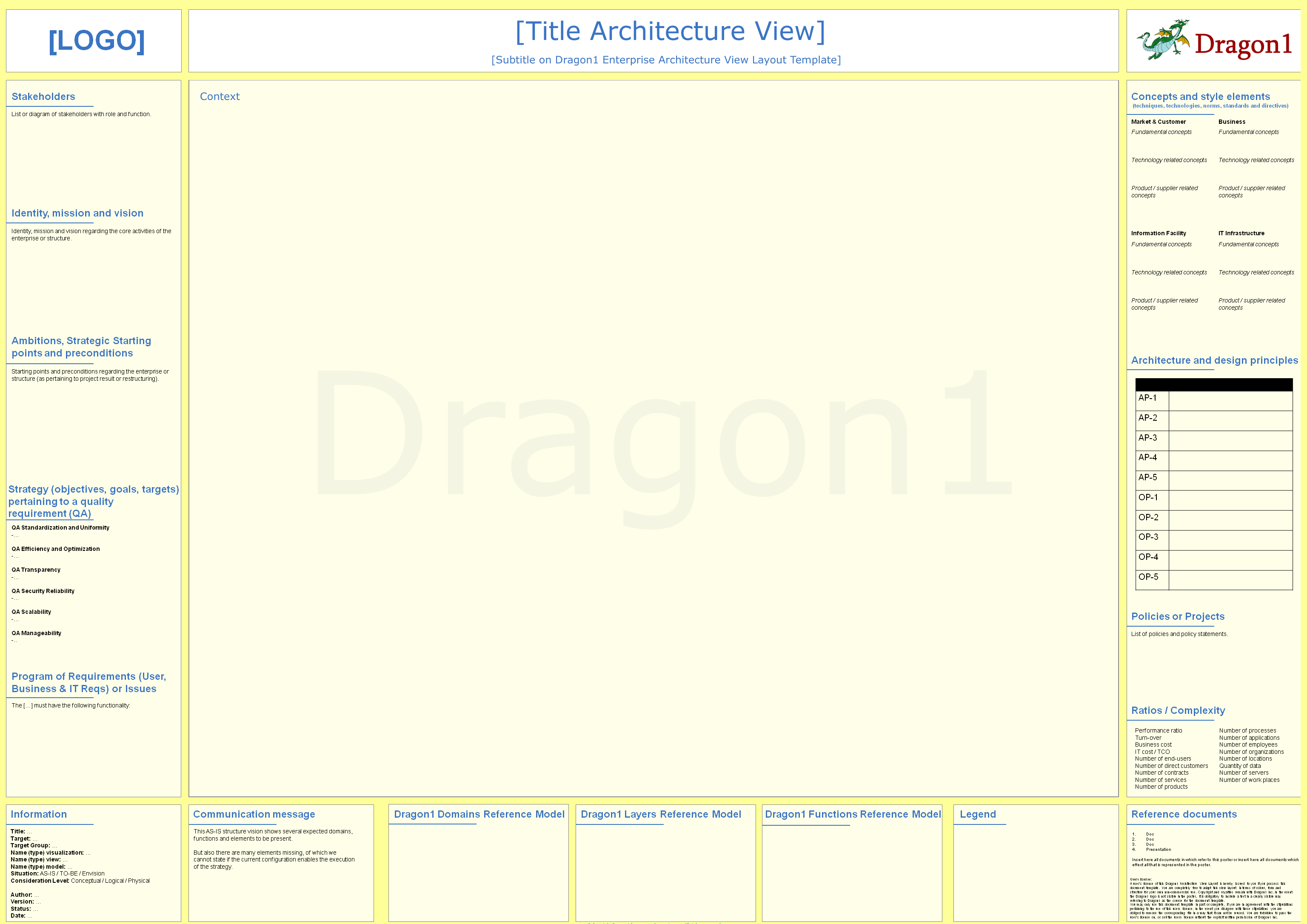What is an Architecture Canvas?
Strategy, Architecture, and Projects at a glance
The Architecture Canvas is the basic visualization template for every architect. The Architecture Canvas was invented in 2003 as a part of the open EA method by Mark Paauwe, one of the founding partners of Dragon1.
The Dragon1 Architecture Canvas provides an effective layout to relate information on Enterprise Strategy, Enterprise Architecture, and Business Transformation with each other. Using the canvas enables you to present and communicate architecture visualizations effectively for decision-making, such as:
- Concept Sketches
- Business Diagrams
- Blueprints
- Landscapes
- Artist Impressions
The Architecture Canvas parts explained
The Architecture Canvas links three different but related areas together:
- Strategy
Enterprise or Business Strategy (left side) - Architecture
Enterprise or Solution System Architecture (center) - Change
Business Transformation or Enterprise Change (right side)
Enterprise or Business Strategy
On the left side of the canvas, there is an area for presenting subjects that are part of the enterprise or business strategy: identity, mission, vision, themes, stakeholders, etc...
Enterprise or Solution System Structure
In the middle of the canvas, there is a space for designing an enterprise system structure or business system structure, often with elements organized in layers: markets and clients layer, governance layer, business layer, information and application layer, and the technology governance layer.
Business Transformation or Enterprise Change
On the right side of the canvas is an area for presenting change subjects, like programs, projects, deliverables, and milestones. Sometimes, concepts, principles, rules, roles, and constraints are present on the right-hand side as well.
Logo and Title on the Canvas
At the top left corner is an area allowing you to apply your logo. Usually, this is the logo of your company or product. In the top center, you can add your title and subtitle to make the Enterprise Canvas stand out.
Communication Message on the Canvas
At the bottom of the Architecture Canvas, you will see a box for the communication message. You have an area here to write down the 'communication message' of this whole visualization: What does it tell the viewer, or what should it tell the Viewer?
By using the communication message, you 'check' the correctness of the visualization. If a viewer looks at the visualization but does not get or see what is written down in the communication message, you, as an architect, might have to do some additional work to improve the visualization.
Bottom Row on the Canvas
The boxes at the bottom row of the Architecture Canvas can be used to add additional relevant information, such as:
- Reference Models
Multiple sorts of Reference Models can be specified. e.g., Domain information, Layer information, or Function Information. - Legend
A dedicated space is reserved (on the right side), allowing you to add a legend in which you can explain the meaning of the symbols being used. - Reference documents
On the right side, you can add information on the information sources that were used to create the Architecture Canvas.
Effect Behavior with the Architecture Canvas
The expected effect behavior is one topic you will not write down on the visualization. In other words, what do you want viewers/stakeholders to do after looking at the visualization? When is the visualization successful? Because that significantly determines what and how you visualize the items on the canvas.
For instance, if you might want people to make a certain decision or take a certain action, you focus the visualization with eye-catchers on only that important message. All the other information on the visualization is grayed out as being contextual.
If you want people to see the dependencies and interrelationships of a situation in the organization (in the middle section), such as blocking the execution of a strategic goal (on the left-hand section), you might want to define a project with a deliverable (on the right-hand section). This way, the Dragon1 Architecture Canvas serves as a strategic management steering instrument with tracking and traceability features.
All Changes are reflected on the Architecture Canvas
The power of the Architecture Canvas is that it is driven by the models you create. The advantage of using models is that model changes are reflected immediately in the Architecture Canvas after you generate it again.


